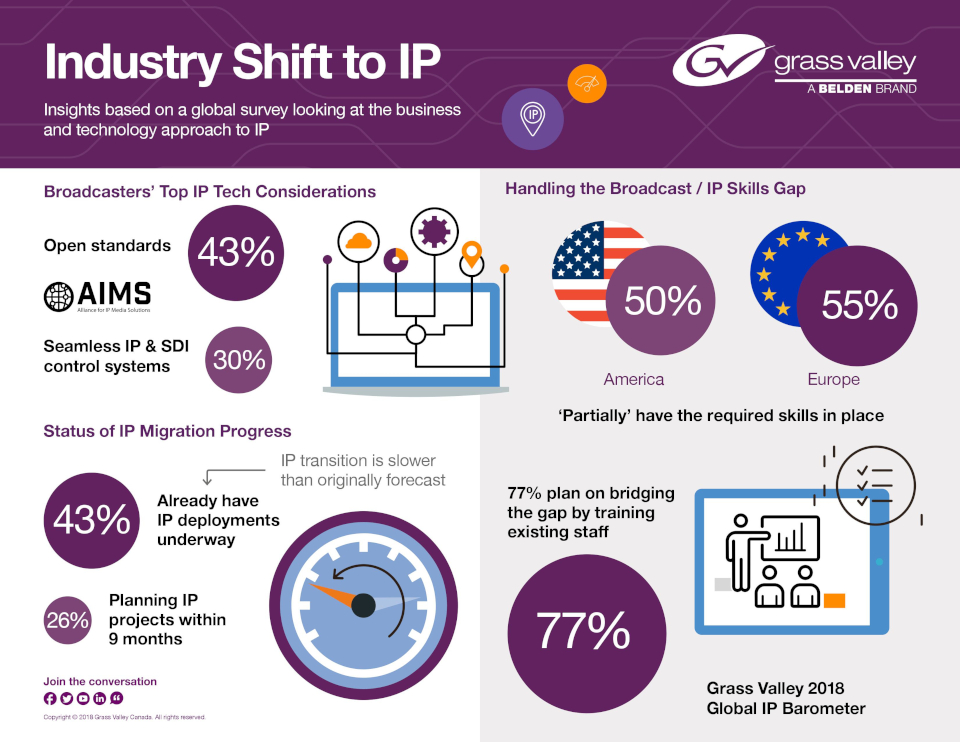New Study Reveals Strong Support For A Hybrid IP-SDI Approach
MONTREAL—Two out of three media industry professionals responding to a 2018 survey on IP uptake favor a hybrid approach of SDI and IP for signal transport and infrastructure, possibly reflecting concern over costs and the desire to get as much mileage out of existing SDI equipment as possible.

The finding — from Grass Valley’s 2018 Global IP Barometer study, which was released today — is consistent with a growing concern over the price tag of an IP transition. The study of some 750 media professionals from the United States, Europe, the Asia-Pacific region, Latin America and the Middle East found the percentage of respondents reporting that cost is their top concern when considering a move to IP has increased from 27 to 32% since the 2017 Global IP Barometer.
Despite the concern, many respondents have ongoing deployments or soon plan to deploy IP-based solutions. The study found that 43% of respondents say they have IP rollouts in the works, and 26% report they are planning to start projects by Q3 2019.
[Read: IP Distribution Challenges SDI]
Perhaps this level of adoption can be attributed to a greater comfort level about the impact of IP on the quality of productions as successful IP installations around the world come online. This year’s study found 22% of respondents say they are concerned about how IP affects quality, down from 31% last year.
“Two years ago, it was clear that the industry recognized and understood how central IP was going to become to workflows and new, innovative ways of working, yet the market lacked the confidence to invest in IP solutions. Now, we’re seeing more broadcasters, OB companies and service providers forging ahead with adopting IP — or making concrete plans to do so within the next nine months,” said Neil Maycock, Grass Valley VP, global marketing.
Other key findings:
Get the TV Tech Newsletter
The professional video industry's #1 source for news, trends and product and tech information. Sign up below.
- Flexibility topped the list of business priorities for a move to IP;
- Nearly half selected an open standards approach as most important from five key technology factors;
- A seamless IP and SDI control system –the second highest technological consideration — was chosen by 30% of respondents;
- By a two-to-one margin, respondents say they prefer working with best-of-breed vendors rather than a single source, underscoring the need for open standards and interoperability.
The study also looked at how respondents characterized the need for IP training inside their organizations and how they intend to address it. Among U.S. respondents, 38% say they believe they have the right skills in place to manage the migration to IP. Thirty-six percent of respondents from Europe say so. Both groups are up from the 2017 survey, which found 36 and 28%, respectively, saying the right skills were in place.
Half of surveyed Americans and 55% of Europeans surveyed say they believe they “partially” have the required skills to manage an IP migration, which compares to 47 and 56%, respectively, last year.
The survey also found that 77% of respondents said they plan to bridge the IP skills gap by training their current staff internally.
According to Maycock, it is “encouraging to note that the skills gap is recognized and is actively being addressed across the industry.”
More information is available on the Grass Valley website.
Phil Kurz is a contributing editor to TV Tech. He has written about TV and video technology for more than 30 years and served as editor of three leading industry magazines. He earned a Bachelor of Journalism and a Master’s Degree in Journalism from the University of Missouri-Columbia School of Journalism.

